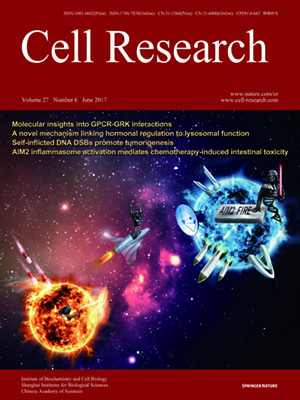
Volume 27, No 6, Jun 2017
ISSN: 1001-0602
EISSN: 1748-7838 2018
impact factor 17.848*
(Clarivate Analytics, 2019)
Volume 27 Issue 6, June 2017: 815-829
ORIGINAL ARTICLES
CRISPR-Cas9-mediated genome editing in one blastomere of two-cell embryos reveals a novel Tet3 function in regulating neocortical development
Lingbo Wang1,*, Min-Yin Li2,*, Chao Qu1, Wan-Ying Miao2, Qi Yin1, Jiaoyang Liao1, Hua-Teng Cao2, Min Huang3,4, Kai Wang1, Erwei Zuo1, Guangdun Peng5, Shu-Xin Zhang2, Guodong Chen6, Qing Li1, Ke Tang7, Qian Yu8, Zhoujie Li8, Catherine CL Wong3,4, Guoliang Xu6, Naihe Jing5, Xiang Yu2 and Jinsong Li1
1State Key Laboratory of Cell Biology, Shanghai Key Laboratory of Molecular Andrology, CAS Center for Excellence in Molecular Cell Science, Institute of Biochemistry and Cell Biology, Chinese Academy of Sciences, University of Chinese Academy of Sciences, 320 Yueyang Road, Shanghai 200031, China
2Institute of Neuroscience and State Key Laboratory of Neuroscience, CAS Center for Excellence in Brain Science and Intelligence Technology, Chinese Academy of Sciences, University of Chinese Academy of Sciences, 320 Yueyang Road, Shanghai 200031, China
3National Center for Protein Science Shanghai, Institute of Biochemistry and Cell Biology, Chinese Academy of Sciences, 333 Haike Road, Shanghai 201203, China
4Shanghai Science Research Center, Chinese Academy of Sciences, Shanghai 201204, China
5State Key Laboratory of Cell Biology, Institute of Biochemistry and Cell Biology, Chinese Academy of Sciences, University of Chinese Academy of Sciences, 320 Yueyang Road, Shanghai 200031, China
6State Key Laboratory of Molecular Biology, Shanghai Key Laboratory of Molecular Andrology, Institute of Biochemistry and Cell Biology, Chinese Academy of Sciences, University of Chinese Academy of Sciences, 320 Yueyang Road, Shanghai 200031, China
7Institute of Life Science, Nanchang University, Nanchang, Jiangxi 330031, China
8Animal Core Facility, Institute of Biochemistry and Cell Biology, Chinese Academy of Sciences, Shanghai 200031, China
Correspondence: Jinsong Li, E-mail: jsli@sibcb.ac.cn; Xiang Yu,(yuxiang@ion.ac.cn)
Studying the early function of essential genes is an important and challenging problem in developmental biology. Here, we established a method for rapidly inducing CRISPR-Cas9-mediated mutations in one blastomere of two-cell stage embryos, termed 2-cell embryo-CRISPR-Cas9 injection (2CC), to study the in vivo function of essential (or unknown) genes in founder chimeric mice. By injecting both Cre mRNA and CRISPR-Cas9 targeting the gene of interest into fluorescent reporter mice, the 2CC method can trace both wild-type and mutant cells at different developmental stages, offering internal control for phenotypic analyses of mutant cells. Using this method, we identified novel functions of the essential gene Tet3 in regulating excitatory and inhibitory synaptic transmission in the developing mouse cerebral cortex. By generating chimeric mutant mice, the 2CC method allows for the rapid screening of gene function in multiple tissues and cell types in founder chimeric mice, significantly expanding the current armamentarium of genetic tools.
10.1038/cr.2017.58
FULL TEXT | PDF
Browse 2025


